
Like it or not, artificial intelligence is already changing up content marketing and other kinds of online writing. While the first wave of AI tools aren't all that smart, they still have their uses. I'm not quaking in fear for my job right now, but I am curious how writers like me will be able to use AI writing tools to speed up some of the rote work and help brainstorm ideas.
There are a few different AI tools aimed at writers out there, but one of the most interesting right now is ChatGPT, OpenAI's chatbot. It isn't actually designed as a marketing tool, but its flexibility allows you to do quite a lot with it. Plus, it can be a free way to check out what AIs are capable of right now. You might be surprised at just how useful it can be—and how unlikely it is to steal my job.
How do AI content generators work?
ChatGPT is an app built by OpenAI using specially modified versions of its GPT (Generative Pre-trained Transformer) language models. It serves both as a way to gather data from real users and as a demo for the power of GPT-3 and GPT-4. There are other GPT-powered tools that use these models to generate content in different ways, for example by writing blog posts or rewording emails. With ChatGPT, they're set up to act like a chatbot and conversational partner—but you still have a lot of access to the underlying GPT models.
The GPT models use a "neural network" to predict what text should come next in any given sentence. Instead of words, they use semantic "tokens," which allow the language models to more easily assign meaning and predict plausible follow-on text. Many words map to single tokens, though longer or more complex words often break down into multiple tokens. On average, tokens are roughly four characters long.

You can think of the GPT models' neural networks as complex, many-layered algorithms with billions of parameters or variables that allow them to take an input—your prompt—and then, based on the values and weightings it gives to the different parameters, output whatever it thinks best matches your request. Ask it for a love song about Zapier, and it will do its best to write one.
GPT-3 vs. GPT-4: Is there a difference in quality?
GPT-3 has 175 billion parameters. OpenAI hasn't revealed how many parameters GPT-4 has, though it's presumably significantly more—though nothing close to the 100 trillion that were being thrown around before its launch. Even still, as OpenAI's CEO Sam Altman has explained, more parameters doesn't necessarily mean more powerful AIs. We've likely reached the point where refinements to the tools, techniques, and training used to build AI models are going to be more important than just making bigger models.
That training data is important: GPT-3 was trained on roughly 500 billion "tokens" from websites, books, news articles, and other kinds of written content. This huge volume of data allows it to respond to a variety of different prompts. It can write emails, poetry, dialog, and, of course, marketing copy. GPT-4 was likely trained on much the same dataset, though again, OpenAI is keeping quiet. For our purposes, we can fairly safely assume that they had access to the entire contents of the internet, with all the weirdness that brings.
While OpenAI recently released GPT-4, access to it is currently somewhat limited. The free version of ChatGPT is still powered by GPT-3.5, as it has been since its launch. If you subscribe to ChatGPT Plus for $20/month, you can submit 25 GPT-4 requests every three hours and have priority access to the GPT-3.5 models.
With that said, as you'll see in this article, for most marketing tasks, GPT-3 is sufficient. While GPT-4 is better at some complex, fact-based tasks, and seems to have a better understanding of what you want it to do, when it comes to generating marketing copy, the results are mostly indistinguishable from GPT-3.
ChatGPT can generate ideas and help brainstorm copy
ChatGPT can be a pretty good brainstorming partner. It's like having another person to talk through copy with, even if they possibly aren't the most qualified expert. While you can't count on it to get every fact correct, it can spit out some good turns of phrase, all without having to hop on a call with another human.
The team at Zapier got ChatGPT to help write their OpenAI integration landing page. It did an overall mediocre job (Zapier humans made it sound better), but it did come up with the line that says you can use OpenAI and Zapier to "combine the power of AI with the flexibility of automation." That's a pretty great bit of copy.
It's particularly helpful if you feel like you're better at writing long-form content than catchy headlines or ad copy. That's me, so I used it to generate some ideas to promote my newsletter.
This is a good test for showing a few of the differences between the GPT-3 and GPT-4-powered versions of ChatGPT. First up, the free version with GPT-3.5.

And now GPT-4:
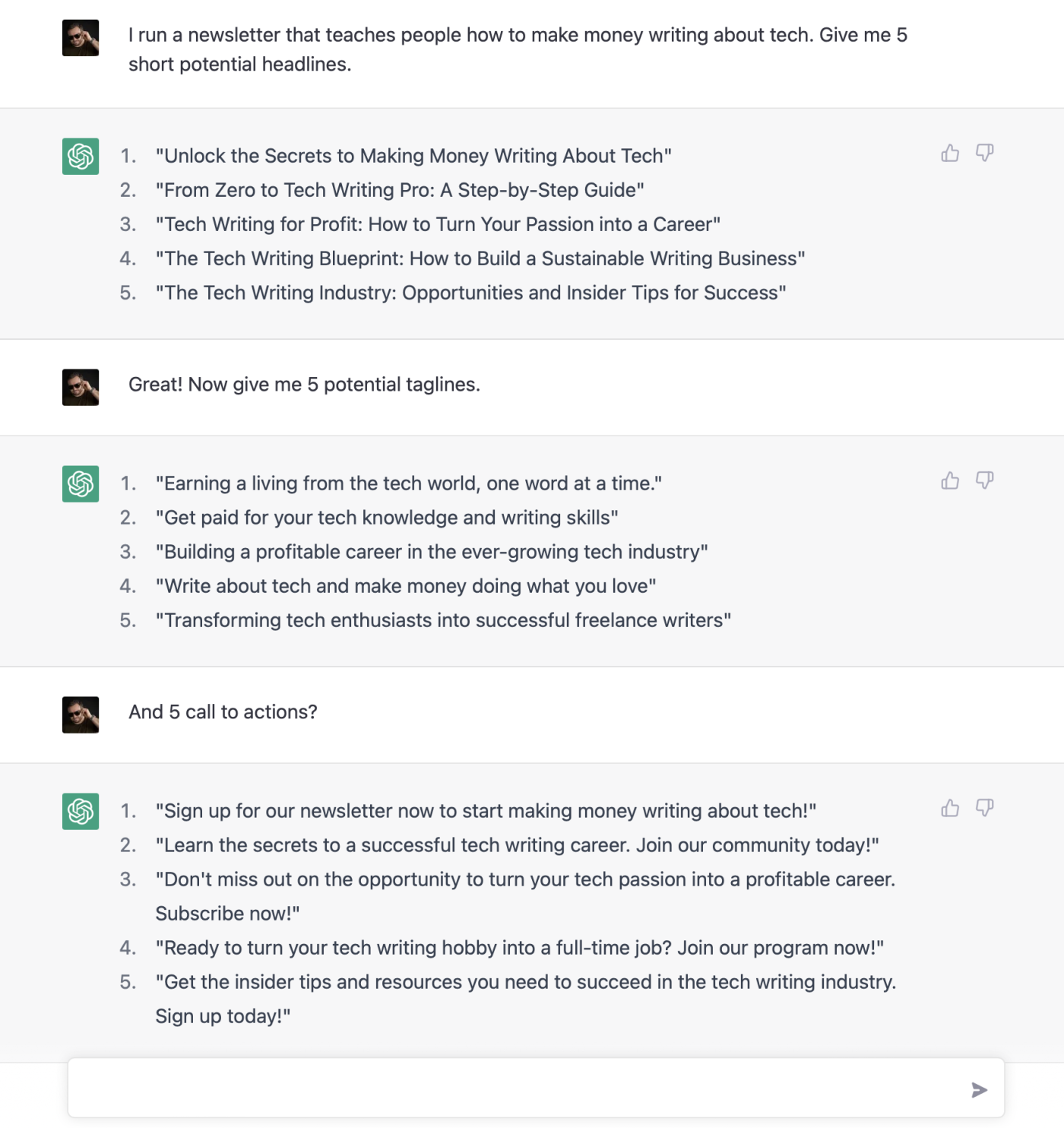
What do you think? Neither model will provide perfect copy from one prompt, but if you ask them for a bunch of suggestions, you can get a whole heap of ideas to A/B test. Both GPT-3 and GPT-4's suggestions above are at least on par with the kind of things I'd come up with in 30 minutes of brainstorming—and they did it far quicker.
As for whether GPT-4 made much difference—I don't think so. Its headlines are arguably more creative and unique, but that makes them a little less SEO-friendly. Similarly, its taglines were almost too out there. Both sets of results are going to need a bit of editing and testing, so I think regardless of which model you use, you'll end up with pretty solid results.
You can also give ChatGPT directions to get better copy: for example, you might ask it to emulate your brand voice or go easy on the exclamation points.
ChatGPT can write SEO meta descriptions
One of the things that ChatGPT is best at is summarizing text that you give it. When it's asked to come up with something totally new, it's a bit of a crapshoot. You could get something great, or it could go off on a wild tangent and totally miss the point. But when you give it a few hundred words to work from, it's far less likely to miss the mark.
That makes it really good at writing SEO meta descriptions. Let's be honest: they all sound like they were written by a bot anyway, so why not make your life easier and actually get a bot to do it? (In the images below, I only gave it the lede to the article, but you can paste the entire article in if you don't need to be able to take a screenshot of it.)
Here's what the GPT-3.5 model gave me:
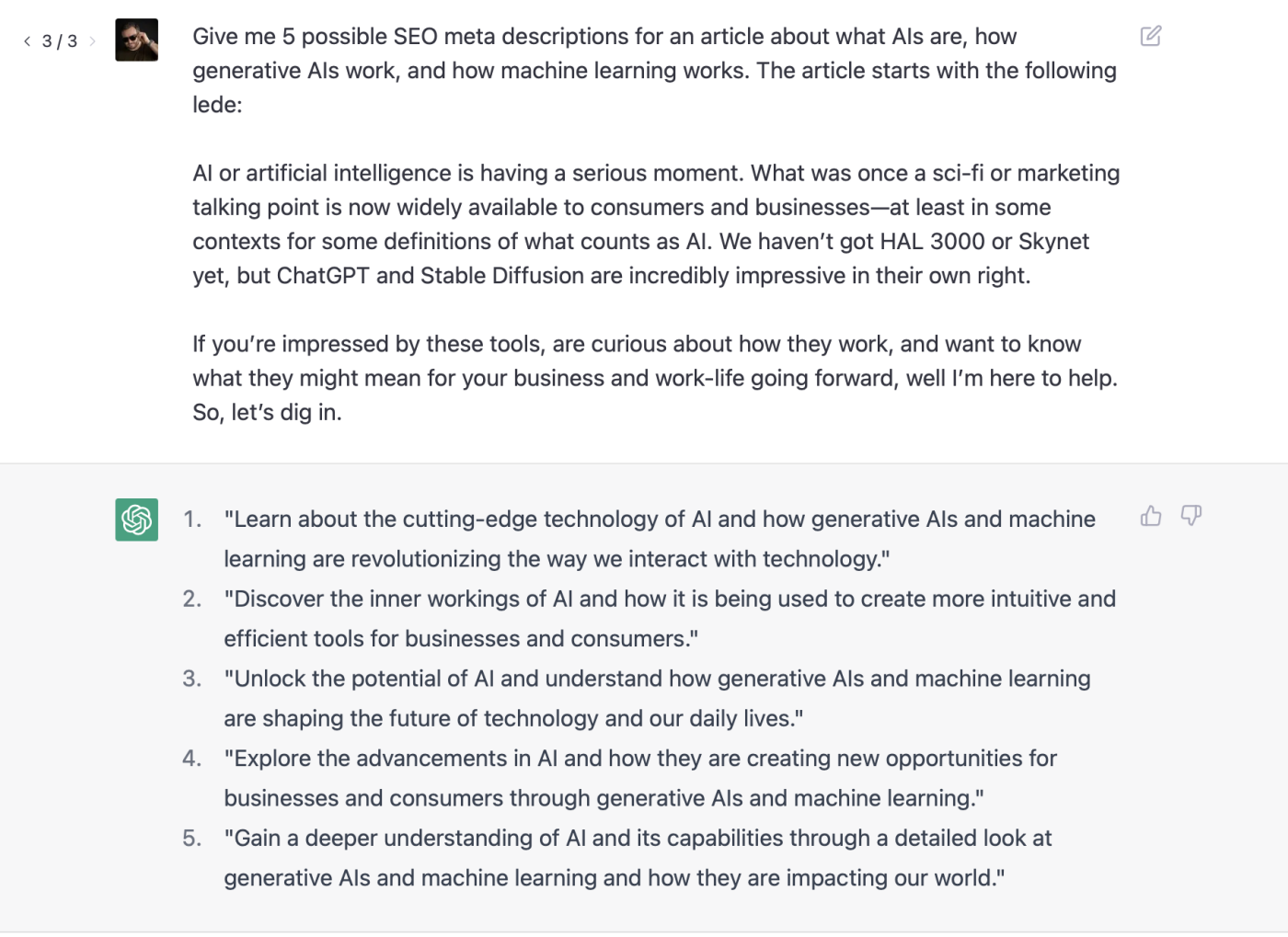
And here's what the GPT-4 model did:
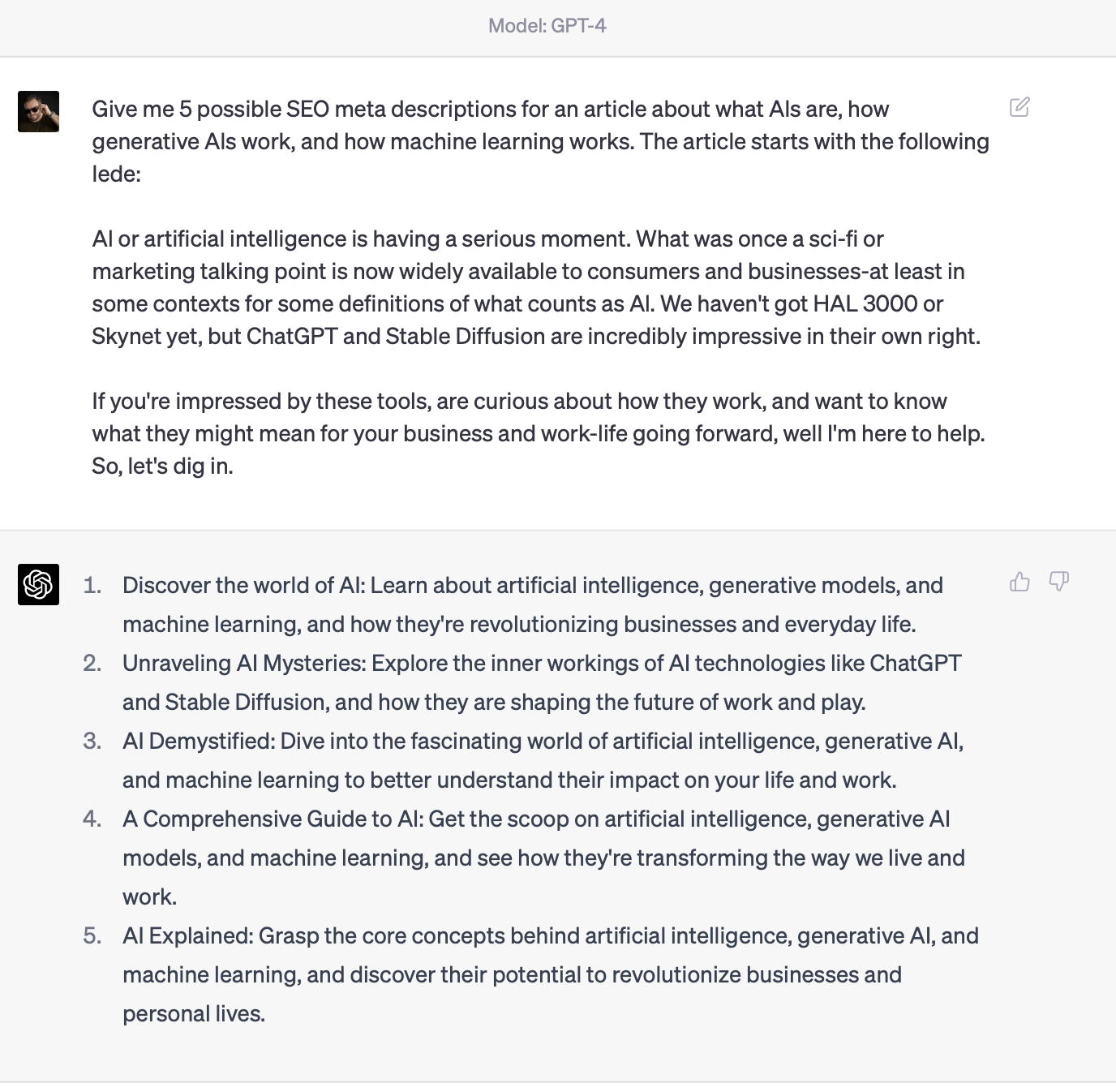
Again, though, neither set of results is perfect. They're solid, but definitely require some tweaking to get a good primary keyword in there.
And that's not necessarily solvable with ChatGPT. One area where GPT-4 shines is taking instructions, though it can be a bit too literal. Let me show you.When I asked the GPT-3-powered ChatGPT to include the primary keyword ("what is AI"), it didn't. And when I asked why, it apologized and then sent some very questionable results.
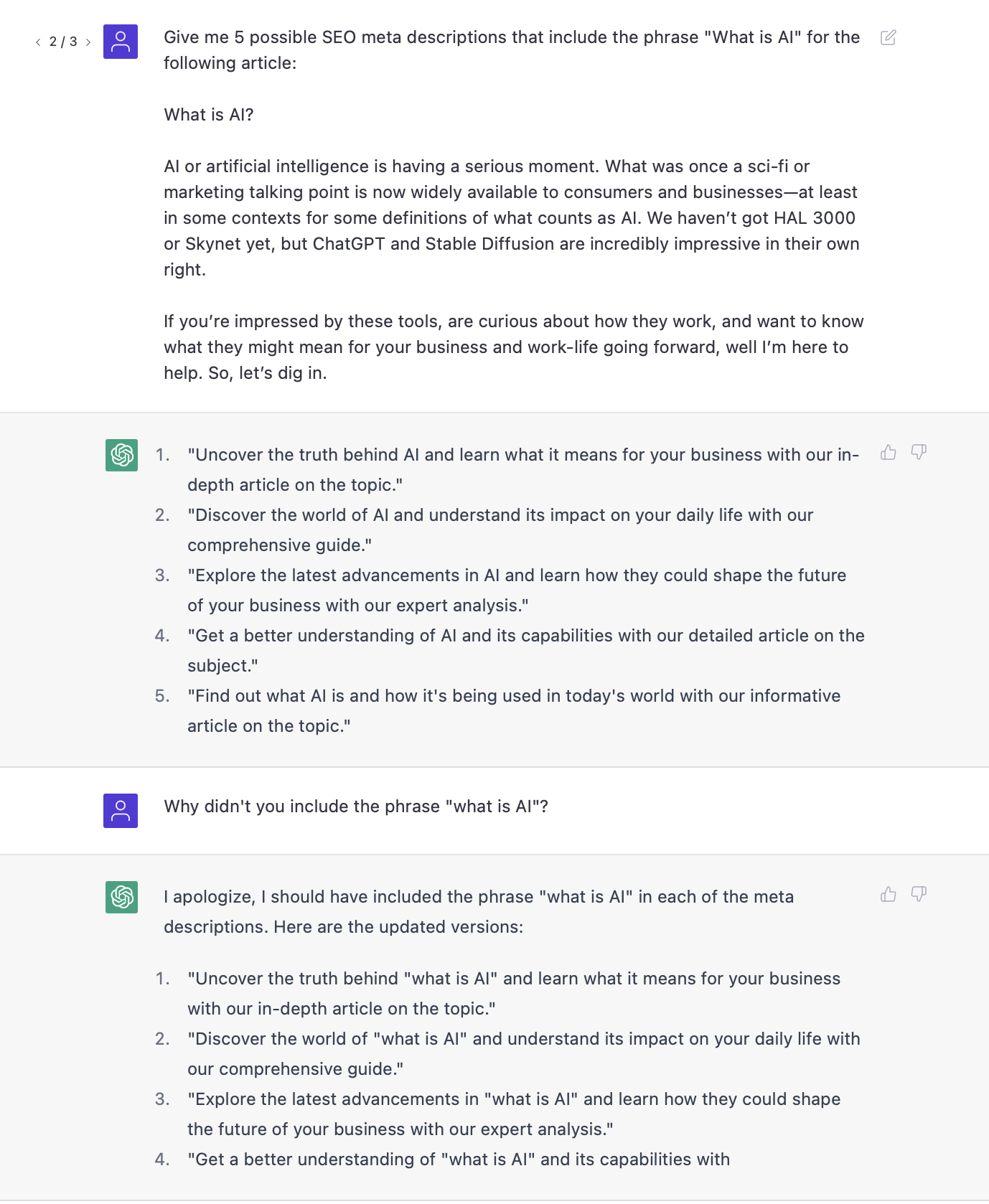
The GPT-4-powered version of ChatGPT at least listened and included the keyword, but wow did it shoehorn it in there.

So, while GPT-4 might be better at including your target keywords, I'm not sure its results are so much better. Certainly, I wouldn't be signing up to ChatGPT Plus thinking that it will solve all your metadescribing needs.
ChatGPT can create rough outlines for blog posts
ChatGPT is at the point where its rough output can give you a good outline to work from for a blog post. But I still wouldn't let it write an entire post for me because, by default, it tends to create simple essays where each point gets a paragraph. GPT-4 is definitely more creative here, but it still has that AI-like quality to it.
Let's start with GPT-3 though.
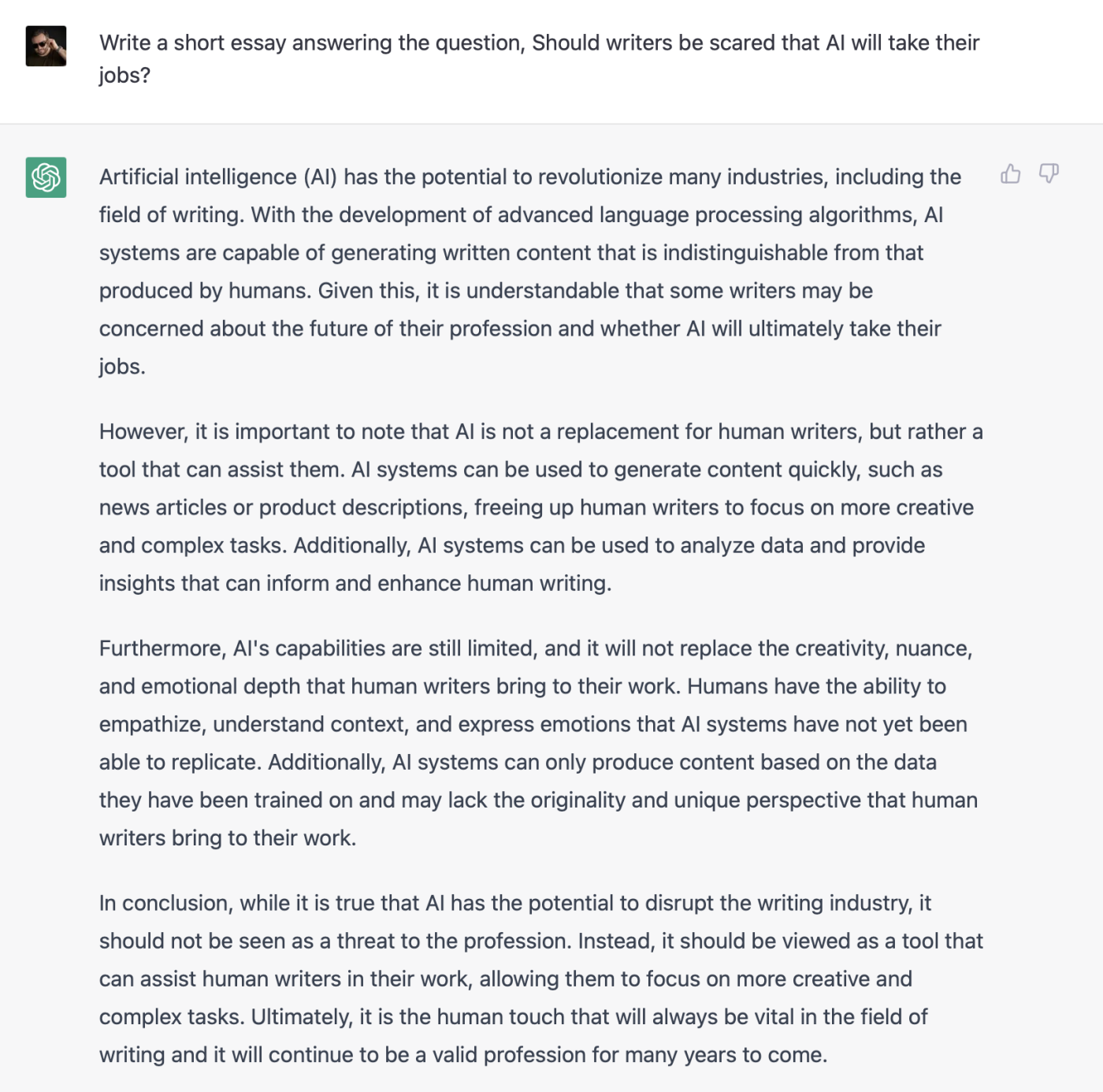
Look, I love that ChatGPT called writing "a valid profession," but the article is dry and formulaic. The conclusion starts with "in conclusion," the last sentence starts with "ultimately," and there are a lot of "furthermore"s and "additionally"s. It's not incoherent, and the points it makes are good and could form the foundation for a much more interesting article with a bit of tweaking, but it's not publishable like this.
Even when you ask it to write more casually or in a particular style, the content it produces can feel a little write-by-numbers.
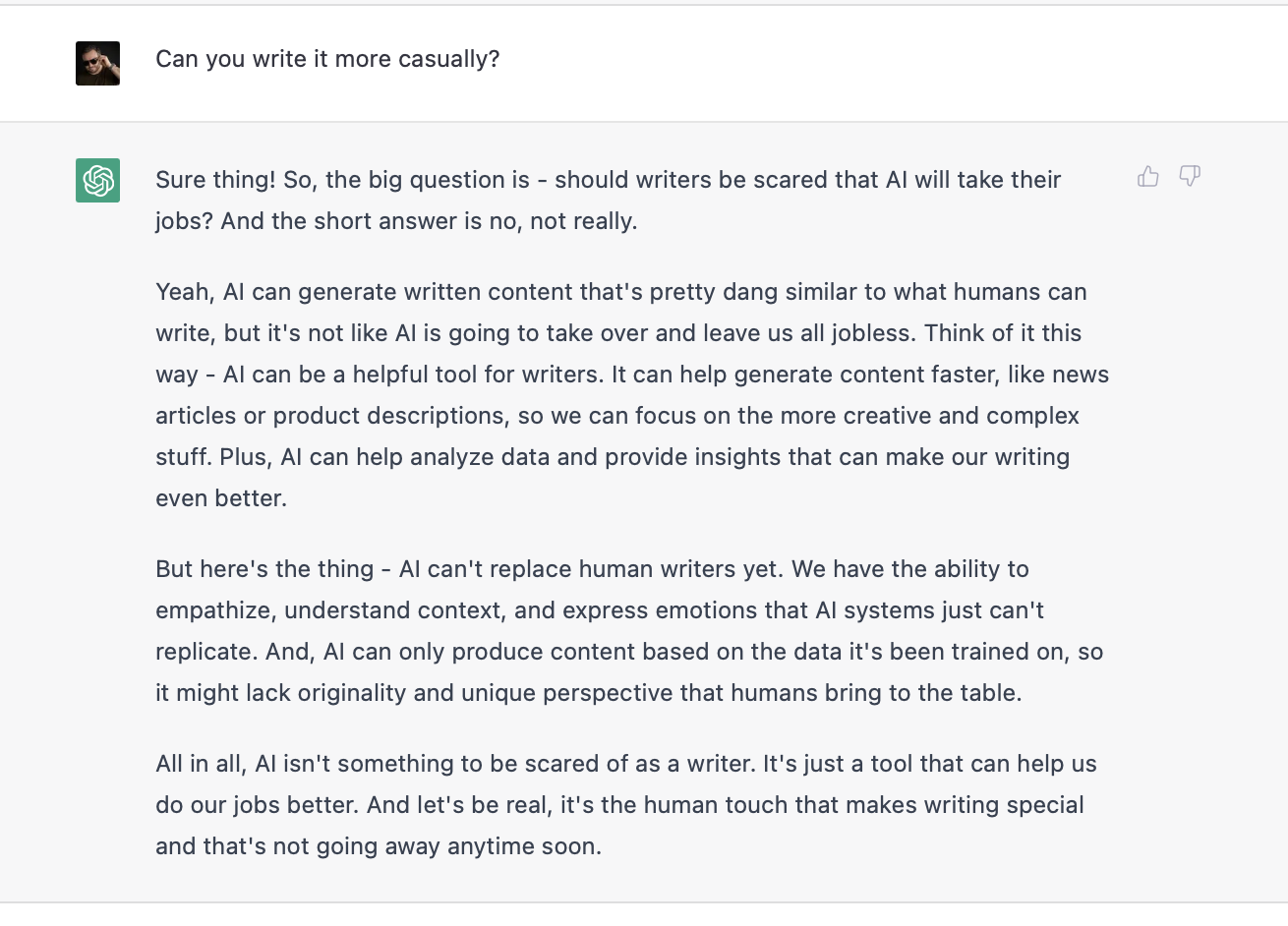
It also lacks a point-of-view. Even though ChatGPT is deeply involved in whether AI can take writers' jobs, it doesn't really have an informed opinion. It's just writing content that could be a fair response to my prompt—not something that it truly feels. Because, you know, it doesn't feel.
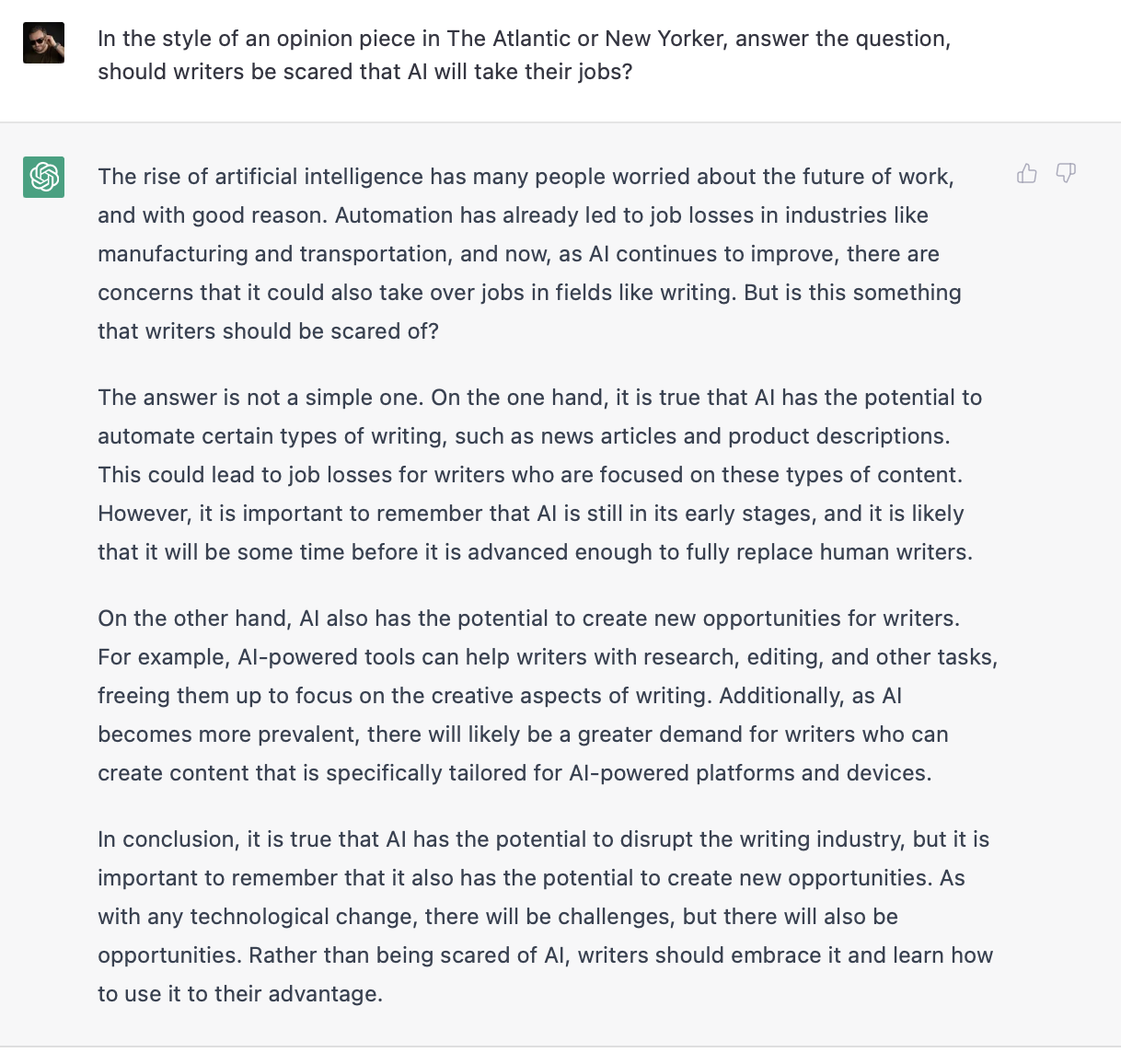
Still—GPT-3 offers upa usable framework to start with. By taking the rough outline that it has given me (and even a few lines verbatim), I can write something much sharper, more opinionated, and of course, more human.
So what about GPT-4?
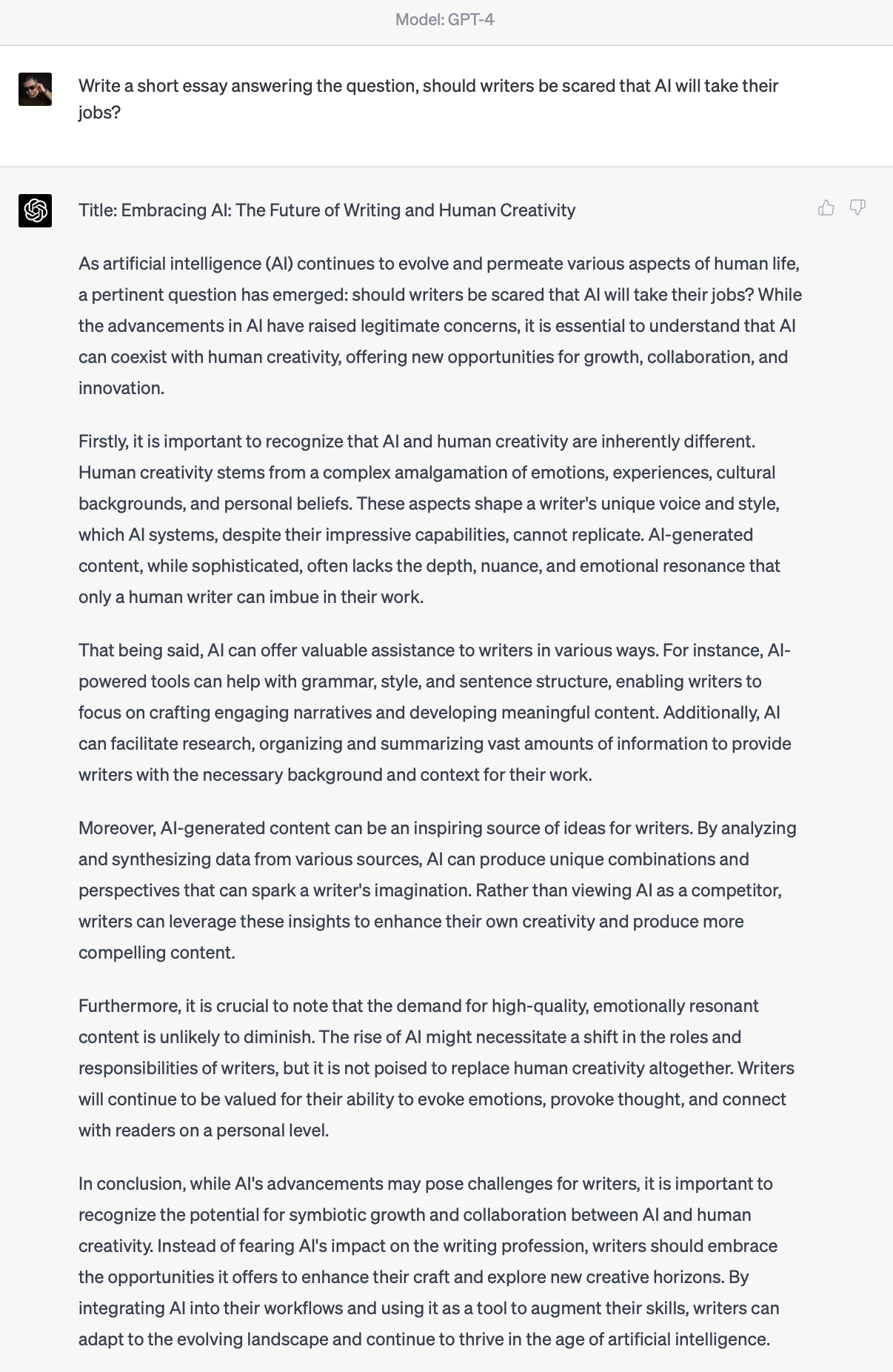
That's definitely a little better, though still pretty heavy on the "moreover"s, "furthermore"s, and "in conclusion"s. It also feels less stilted, so would likely take a bit less tweaking and rewriting to get into publishable shape.
When asked to write more casually, things got very silly. I'm sure I could have gotten better results with a different command, but this is too funny not to leave it as is.
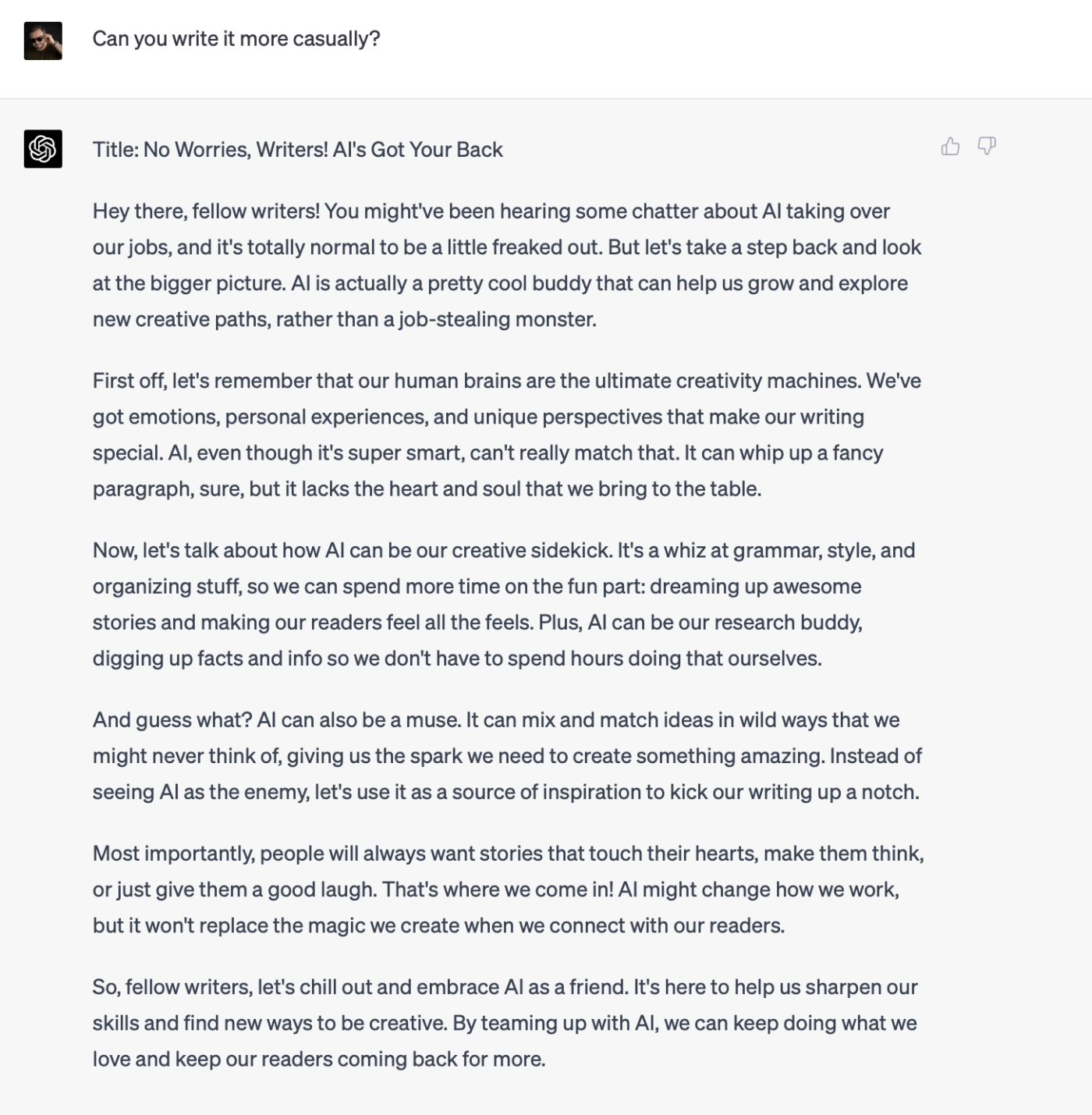
Its take on The Atlantic and New Yorker's style was also a lot better. The opening lines are an excellent pastiche, though I'm not sure they'd make it into print. Still, GPT-4 seems to have a much better grasp of what I'm looking for here, even if the broad contents and structure remain much the same.

Based on my experiments—and as you can see from these examples—GPT-4 gets you a lot closer to something publishable with less editing, even if it's not perfect and still has a formulaic quality to it. While it would be unethical to just post this without saying an AI was involved, it's hard to argue that GPT-4 doesn't give decent results.
AI can make sure you don't miss anything obvious
My favorite way to use ChatGPT is to get it to summarize all the really obvious points about a particular subject or argument so I can make sure I didn't miss anything. Because GPT is built on top of huge amounts of written material pulled from the entire corpus of human knowledge and works by predicting the most likely follow-on text, it's really good at hitting all the major talking points on most subjects.
For this one, GPT-3 is basically as good as GPT-4, though GPT-4 gave me a more detailed response.

Having said that, maybe GPT-4 is right to skip the safety hazard to low-flying aircraft aspect.
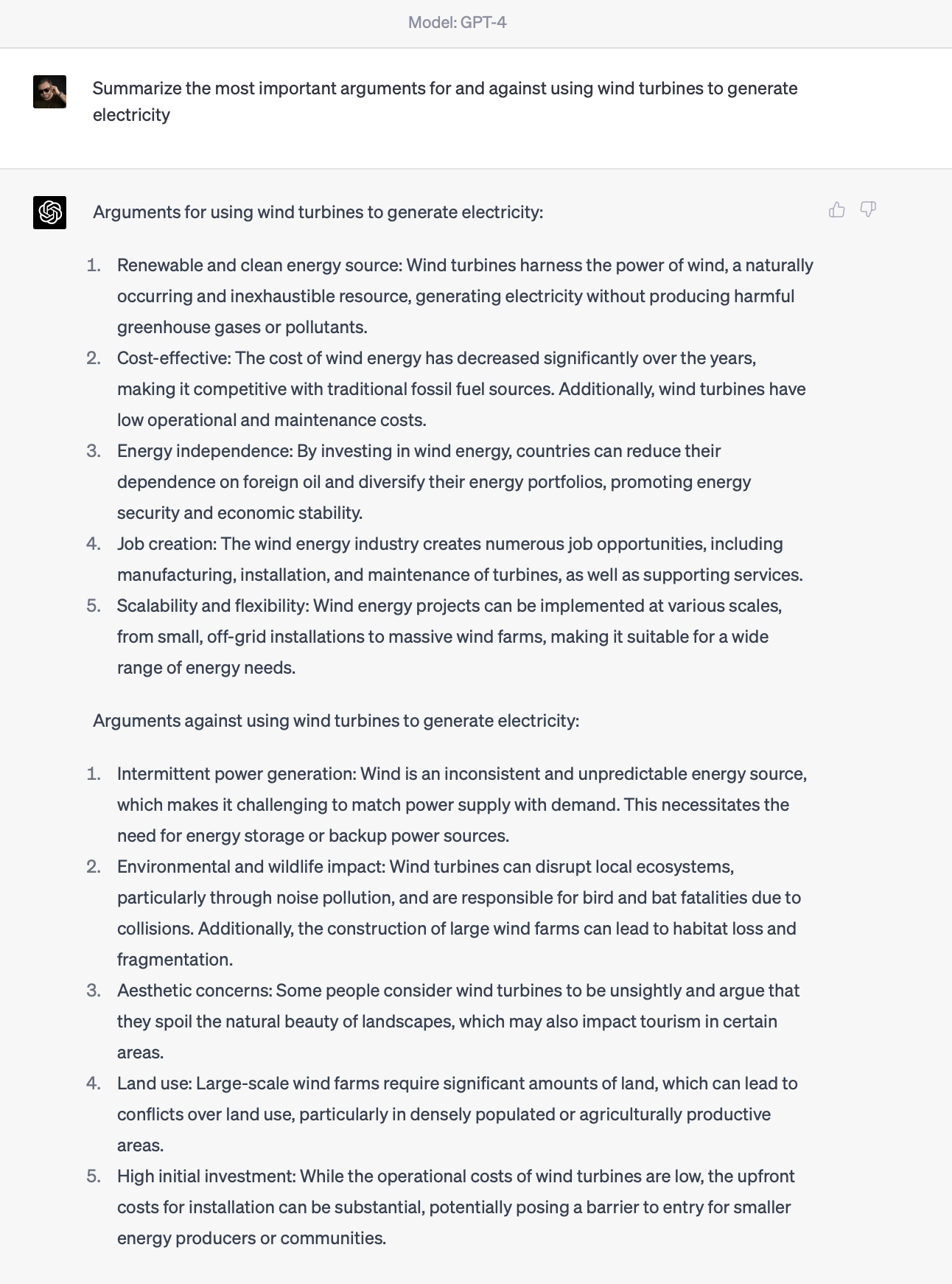
If you're writing a blog post, an answer to a FAQ, or some other informative bit of content for your customers, ChatGPT with any model can do a pretty good job of making sure you address the issues that anyone reading it will expect you to touch on. You obviously don't have to (and probably shouldn't) copy its points word for word, but it's a good bit of insurance to make sure you don't miss anything important.
Sync your marketing activities across other apps
If you're already using ChatGPT to write content, brainstorm ideas, or create blog outlines, you can use Zapier's ChatGPT plugin to connect ChatGPT to your marketing apps and automate tasks that involve your AI content.
As an example, you might ask ChatGPT to create a blog outline.
Using the plugin, you can then ask it to add the text directly to a Google Doc (with that outline).
Anytime ChatGPT creates decent content for you, just ask it to drop it in a Google Doc, and it'll be there, waiting for you to start working on it.
That's not the only use case, though. Say you ask ChatGPT to summarize key points of a specific topic you're writing about. Once it's finished summarizing, you can ask it to create a task in Airtable, Todoist, or Asana with that information, to help you keep track of everything you're working on, without the copy-pasting. It's like your own helpful marketing assistant.
What can't AI do?
While ChatGPT can offer up the occasional great turn of phrase, it struggles to reliably deliver exceptional copy—especially if you want something unique. Left to its own devices, GPT-3 generally churns out formulaic, high school-style English (see: meta descriptions), rather than anything that's likely to entice people to read more. GPT-4 is a good bit better, but I still don't think it's coming for my job any time soon. Either way, it's impressive that a computer can write like this at all—but that isn't reason enough to just publish what it writes without a bit of editing. ChatGPT is at its best when you ask for multiple options and tweak things yourself, rather than treating it as a hands-off marketing tool.
It's also important to remember that almost everything ChatGPT spits out sounds plausible and looks reasonably coherent. Unfortunately, it's sometimes plausible-sounding nonsense. When I was looking at one viral blog post about the ways marketers could use ChatGPT, I found a bunch of ideas that just…didn't work. For example, it suggested using ChatGPT to generate a list of popular blogs that cover remote work. Of the five suggested, three were dead links, one was a marketing site for a psychic, and one was a remote work job site. All the URLs and descriptions sounded plausible, but it wasn't actually useful information. When I tested it again with GPT-4, the results looked even more plausible—but weren't a whole lot better. (It even suggested I just use Google to get better results.) So, if you don't actually confirm what ChatGPT has said, you're likely to be duped.
Similarly, ChatGPT isn't up-to-date on current affairs or familiar with the intricate details of your product. If you leave it to its own devices, it will give you a lot of vague generalities. And GPT-4 doesn't fix that. Both have limited knowledge after September 2021. If you have ChatGPT Plus, you can access ChatGPT's internet browser (which is powered by Bing), but that's a lot more cumbersome and still doesn't really solve the issue at hand.
In the words of ChatGPT, it "should be viewed as a tool that can assist human writers in their work, [so they can] focus on more creative and complex tasks."
Add AI to your workflows
ChatGPT is still more of a for-fun tool, but the AI models that power it can be embedded into your workflows to do things like automatically brainstorm content ideas, create outlines every time you add a topic to your ideas list, or generate subject lines for each new webinar you want to promote.
With Zapier's ChatGPT integrations, you can incorporate AI into all of your workflows. Take a look at how to automate ChatGPT, or start with one of these pre-made workflows.